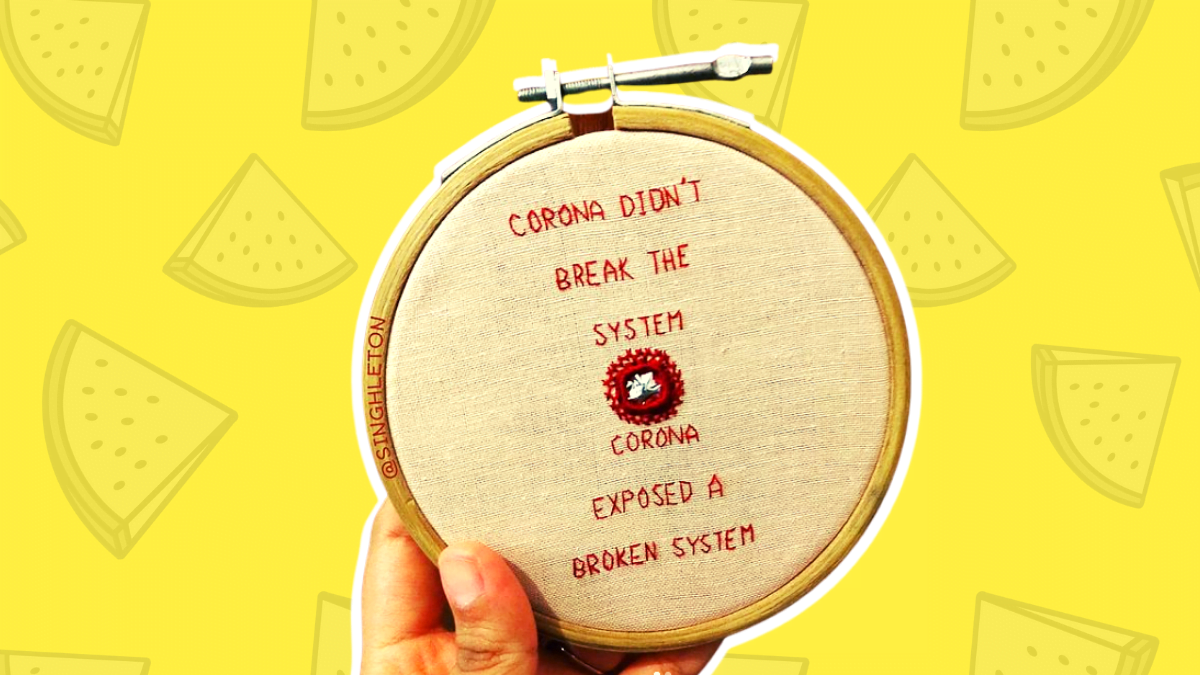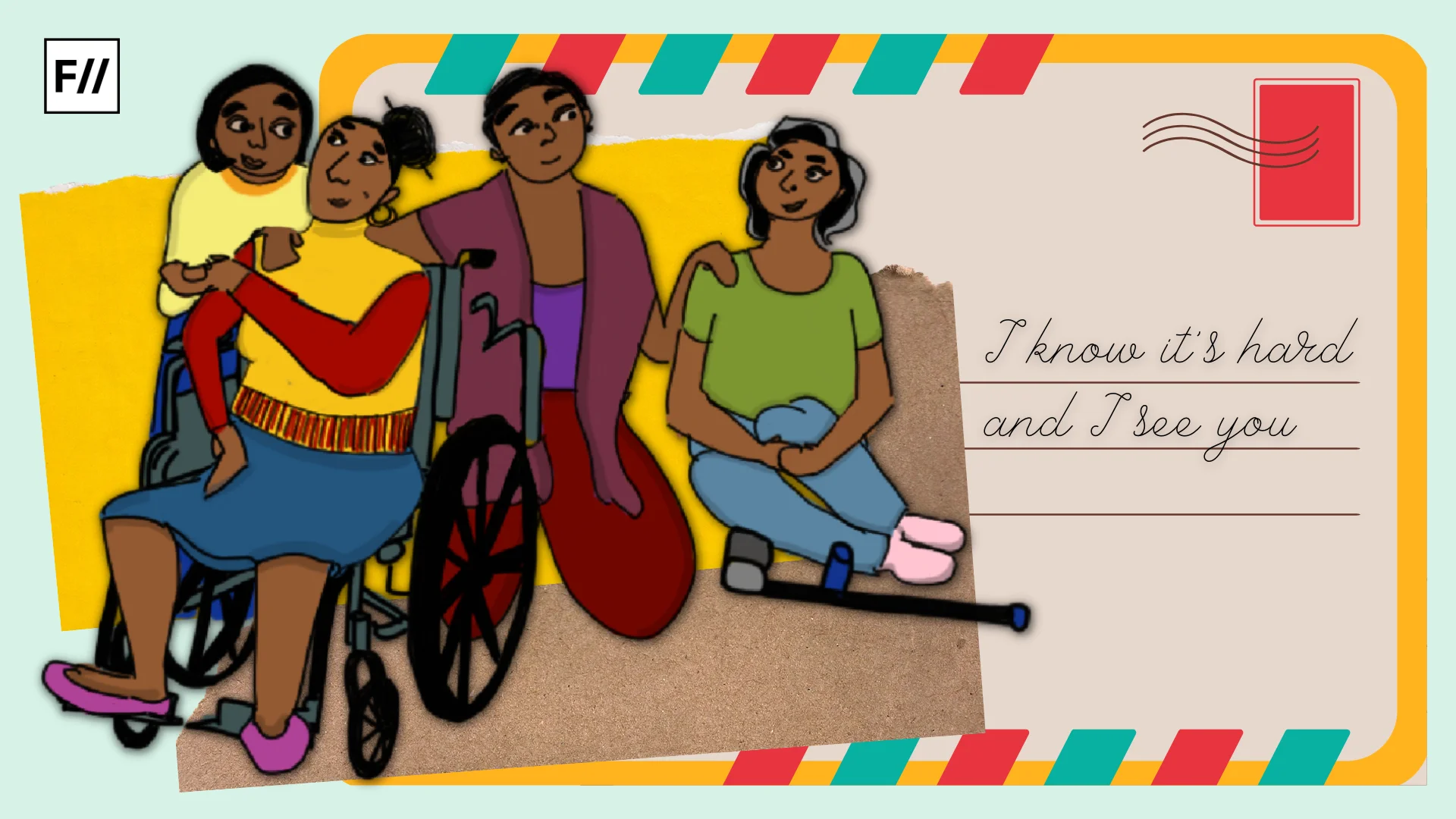“Our traditions of weaving and embroidery carry stories of gender and caste in our culture. If you take a look at older phulkaris or kantha pieces or embroidered shawls, they tell stories that might have otherwise been never heard. That in itself is a form of deep activism.” Embroidery is one of the oldest forms of craft that was practised by women. We are well aware any form of domestic labour never gets the deserved recognition and embroidery was no different. For centuries it has been undervalued and neglected because women created it. It was never even considered an art, women were restricted to their normative role of embroidering within the four walls. Artist and activist Singhleton has reclaimed this art, and she uses this beautifully to talk about current events and as a mode to dissent. This is her way to pay homage to her grandmother and their mothers for keeping the art alive. Her work is stubble short and to the point. as she correctly says, “my needle has a point!”
Singhleton (she/her), is an embroidery artist based in New Delhi. She has been working in the social justice space for some years now and loves experimenting with different mediums of expression and activism. She was first introduced to embroidery in school as a young girl. She picked up embroidery again when she came across its history as a subversive feminist medium and a turmoil in her personal life. She now expresses her activism and dissent through embroidery.
She calls her aesthetic, ‘textual textiles.’ She uses text along with one or two design elements in most of her pieces. “I’m a fan of the written word, and thoroughly enjoy wordplay, so that’s found a way into my craft. I also try to bring in elements of phulkari, which is my inherited craft.” She also tries to challenge dominant aesthetics and narratives through this. Her canvas goes beyond cloth, it has postcards, leaves.
She also views it as an interesting metaphor for care and justice. “Our freedom, our pain, is interconnected.”
Also read: Theatre For Change: Theatre For Engagement, Not Solely Entertainment
Through her work she is not just weaving on cloth, she is weaving stories and history. She adds stories of her ancestors, present, and her future. If she uses a piece of khadi woven by someone in Himachal, she is building on the stories that they have weaved into the cloth.
Her inspiration for taking this up is to challenge the notion about embroidery. Embroidery has always been a strictly feminine work, limited to the domestic domain. The indian culture that encourages embroidery, limits it to saree, kurti and shawl for beautification, it does not allow the women to voice their opinion. Bhartiya naari is not supposed to resist or revolt. Singhleton uses this craft to liberate other women from the shackles of patriarchy. Her work symbolises rebellion, cultural revolution, and as the voice of women who never got a chance to have their own.
Artist and activist Singhleton has reclaimed this art, and she uses this beautifully to talk about current events and as a mode to dissent. This is her way to pay homage to her grandmother and their mothers for keeping the art alive.
Her mode of expression is rebellious, it stands up to centuries of colonialism, patriarchy and capitalism. Embroidery connects us to our roots, it’s an art Indian woman passed on from a generation to another. This connection to her country reflects in her work, most of it is in regional language or Hindi. Her work mainly consists of one-liners that highlight the sad affairs of our country, her subtle wordplay and satire have a lasting impact on the viewer. Her political art is powerful and to the point. Within an image the capsules the entire incident and puts her opinion across
In her work, we also find a sense of hope. There is art about radical hope, kindness, love and forgiveness. This creates an intersection of politics and romance. Her work is a refreshing break from cancel culture and provides the comfort to make mistakes and grow.
Singhleton (she/her), is an embroidery artist based in New Delhi. She has been working in the social justice space for some years now and loves experimenting with different mediums of expression and activism.
We also see her artwork honouring revolutionary poets and writers. Faiz, Manto, Paasha and her favourites Amrita Pritam, Shiv Kumar Batalvi. When asked about her idea of resistance and revolution, she said “Resistance is hope. And there’s no one singular way to be hopeful. Your pain may come from one story and mine from another, but our journeys will forever be interconnected. And that multiplicity of hope, and of resistance, have to come together to build a revolution.”
Also read: Photo Essay: Celebrating Dasa Mahavidya Through Drag And Inclusive Imagery
She is currently running a small project, Rafunaama, which is an archive of stitched resistance. The project (earlier South Asian Craftivism) started with her personal need to learn more about embroidered practices in the region. She believes embroidery is an art handed down from one generation to another, it has shared history. She wishes to explore that and document that shared history, and now a shared present through Rafunaama.
About the author(s)
Vasudha Chandwani is a fourth year law student studying at ILS Law College, Pune. She loves reading and enquiring about new things while also finding out ways to keep the struggle against oppression alive. She considers herself an aficionado of tea and loves gardening and binging shows with female protagonists in her free time.




